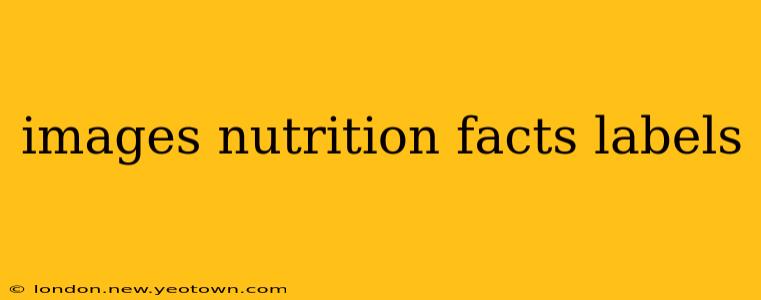Have you ever stared blankly at a nutrition facts label, feeling utterly overwhelmed by the sea of numbers and percentages? You're not alone. Many find these labels confusing, despite their intention to provide clear nutritional information. But what if I told you that understanding these labels is simpler than you think, especially when you combine visual cues with the printed information? Let's embark on a journey to decipher the mysteries hidden within these small rectangular boxes.
Imagine this: You're at the grocery store, faced with a shelf packed with seemingly identical cereal boxes. The vibrant colors and cartoon characters beckon, but you're on a mission for a healthy breakfast option. This is where the power of the nutrition facts label – and cleverly interpreting its data through images – comes in.
What are the Key Components of a Nutrition Facts Label?
A nutrition facts label is essentially a snapshot of the nutritional content of a food product. It's a standardized system, so you can easily compare different brands and products. The key components include:
-
Serving Size: This is the foundational element. Everything else on the label is based on this specific serving size. Pay close attention to it, as a larger serving size can skew your perception of the overall nutritional content. Think of it as a consistent unit of measurement, allowing for accurate comparisons.
-
Calories: This indicates the energy your body will get from one serving. Keep your daily calorie needs in mind when comparing options.
-
Nutrients: The label lists various nutrients like total fat, saturated fat, trans fat, cholesterol, sodium, total carbohydrates, dietary fiber, total sugars, added sugars, protein, and various vitamins and minerals. These are presented as either grams, milligrams, or percentages of the Daily Value (%DV). We'll delve deeper into interpreting these values later.
-
% Daily Value (%DV): This percentage tells you how much of a particular nutrient one serving contributes to your recommended daily intake based on a 2,000 calorie diet. A higher percentage doesn't automatically mean "better," depending on your dietary goals. For example, a high %DV for added sugars might not be ideal.
How Can Images Help Me Understand Nutrition Facts Labels?
While the text-based information is essential, incorporating visual elements significantly improves understanding. Imagine a pie chart representing the percentage of calories from fat, carbohydrates, and protein. This immediately offers a visual representation of macronutrient distribution.
Similarly, a bar graph comparing the sodium content of different brands of crackers could be incredibly helpful. Visual comparisons make it easier to identify healthier options and make informed decisions.
Furthermore, using color-coding—green for nutrients you want more of and red for those you want less of – can highlight areas of importance, making the data more digestible.
What are the Common Misinterpretations of Nutrition Facts Labels?
Serving Size Confusion:
Question: How do I avoid misinterpreting the serving size on a nutrition facts label?
Many people make the mistake of ignoring serving sizes, consuming multiple servings without adjusting the nutritional values accordingly. Always double-check the serving size and multiply the values if you consume more than one serving.
%DV Deceptions:
Question: How can I accurately interpret the %DV on a nutrition facts label?
Remember that %DV is based on a 2,000 calorie diet. Your individual needs may differ. A 5% DV or less is generally considered low, while 20% DV or more is considered high. However, this guideline should always be considered in the context of your overall diet.
Added Sugar vs. Natural Sugar:
Question: What’s the difference between "added sugars" and "total sugars," and how can I tell the difference on the label?
The label will list both "total sugars" and "added sugars." Total sugars include naturally occurring sugars found in fruits and dairy, while added sugars are those that manufacturers add during processing. Focus on minimizing added sugars, as they often contribute empty calories.
The "Healthy Halo Effect":
Question: How can I avoid making decisions based on misleading marketing claims (like "low fat" or "sugar-free")?
Always read the entire label carefully! Don't get fooled by single claims. A product might be "low fat" but high in added sugars, for example.
Conclusion: Become a Nutrition Facts Label Detective!
By combining the information provided on the label with visual representations, and by understanding common misinterpretations, you can become a confident and informed consumer. Don't let the confusing numbers intimidate you – take control of your food choices, and become a label literacy expert. You’ll be surprised at how much easier it is to make healthy choices once you master the art of decoding the nutrition facts label.

